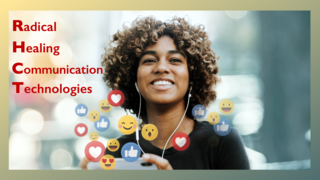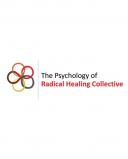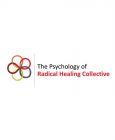Media
Curating Radical Healing Communication Technologies
BIPOC communities create digital spaces for wellness and liberation.
Posted August 2, 2021 Reviewed by Abigail Fagan
Key points
- Digital platforms can promote social connection, increase positive functioning, and reduce mental health challenges, research suggests.
- The Psychology of Radical Healing framework is a process for BIPOC that acknowledges oppression while fostering actions grounded in liberation.
- Technology use by BIPOC includes strength and resistance, critical consciousness, radical hope, and social support, among other traits.

By Danyelle N. Dawson, Helen A. Neville, Hector Y. Adames, Nayeli Y. Chavez-Dueñas, Bryana H. French, Jioni A. Lewis, Grace A. Chen, & Della V. Mosley
“You can’t use up creativity. The more you use, the more you have.” —Maya Angelou
“Technologies create users through discourses, through practices, and through materiality, while people bring their understandings of self to those practices.” —Dr. Andre Brock
Social media is a powerful tool to connect, learn, and build community. From resisting oppression to promoting individual and collective healing, Black, Indigenous, and People of Color (BIPOC) use social media creatively. TikTok trends and witty videos on social media can make us laugh and bring us joy. We also turn to social media to learn more about recent racist incidents or the latest racial discriminatory policy. Connecting to virtual communities of like-minded people provides us opportunities to speak out and take action against racism and other forms of discrimination. In many ways, these digital spaces help us to feel a little less alone.
Research in cyberpsychology – or the study of the intersections of technology, human behavior, and well-being – has documented the utility of digital platforms to promote social connectedness, adaptive behaviors, and positive functioning. Emerging research also suggests that engaging in online spaces may minimize the negative mental and physical health impacts of racism.
For example, Volpe and colleagues found that BIPOC young adults’ critical understanding of digital media buffered the experiences of online racism and post-traumatic stress symptoms. In this blog, we apply the Psychology of Radical Healing framework to discuss how BIPOC communities use communication technologies (e.g., social networking sites, podcasts, and virtual communication platforms) to center collective healing in the face of ongoing individual, interpersonal, and structural racism.
Radical Healing in a Digital World
The Psychology of Radical Healing framework is designed to help BIPOC envision a collective healing process that simultaneously acknowledges the pain of oppression while fostering actions grounded in justice and liberation. From this perspective, healing occurs when BIPOC gain critical consciousness about their oppression and actively seek and implement ways to resist injustice. This work is accomplished individually and in community with others. Promoting and supporting the healing and liberation of BIPOC communities requires people to build on cultural strengths and resistance, critical consciousness, cultural authenticity, radical hope, and collectivism and social support — the five anchors of the Psychology of Radical Healing framework.
We introduce Radical Healing Communication Technologies (RHCTs) as digital platforms used by BIPOC for healing and liberation that engage the five anchors of the Psychology of Radical Healing framework. RHCTs are critical in the digital age — they assist communities to connect and build networks of support, resistance, and joy. Below we highlight examples of BIPOC communities using RHCTs. We also provide recommendations for how we can curate RHCTs in our own personal and professional lives.
Radical Healing Communication Technologies used by BIPOC
Strength and Resistance
BIPOC communities often draw on their cultural strengths and histories of resistance to live joy-filled lives. Part of this resistance includes using social media to share and process experiences of racism, engage in activism, and organize against oppression. For example, for ‘Black Twitter’ users, hashtags, retweets, and threads serve as conduits for connection and resistance, creating online counterspaces without physical or temporal borders. Hashtags like #BlackGirlMagic, #BlackBoyJoy, and #IfTheyGunMeDown represent collective responses to oppressive conditions and narratives.
These collective efforts promote reimagined narratives that center the strengths, humanity, and thriving of Black people. Virtual discourse spaces like ‘Black Twitter’ that support and encourage collective acts of resistance can be understood as radical healing communication technologies.
Critical Consciousness
RHCTs that encourage individuals’ capacity to reflect and act upon one’s sociopolitical reality critically are crucial to working towards our collective liberation. Podcasts such as All My Relations, hosted by Matika Wilbur (Swinomish and Tulalip) and Adrienne Keene (Cherokee Nation), challenge listeners to think deeply about the issues impacting Indigenous communities by engaging in conversations that transcend time and space. They also allow the audience to build critical awareness of damaging narratives and systems of oppression that impact their lived experiences.
Similarly, online toolkits like the Asian American Racial Justice Toolkit and the Immigration, Critical Race, and Cultural Equity (IC-RACE) Lab’s Toolkits encourage the analysis of the interconnectedness of BIPOC issues within the structures of white supremacy culture. These digital toolkits showcase the utility of technology in increasing critical consciousness and facilitating radical healing.
Cultural Authenticity and Self-Knowledge
Radical healing requires a sense of self-determination, a rejection of notions that BIPOC are defined by their oppressors or oppression, and pride in one’s ethnic and racial heritage. Online and digital BIPOC communities have consistently emerged across media and technology platforms (e.g., TikTok, Facebook, Twitter, Instagram), creating spaces to explore and celebrate rich cultural histories and foster a sense of cultural pride and collective identity. For example, with the rise of TikTok, Latinx TikTok users connected across the platform promoting Latinx Heritage and Cultural Authenticity as a means of honoring their heritage and expanding youth’s access to knowledge of cultural traditions.
For many BIPOC communities, the rise of video and audio conferencing platforms, such as Zoom and Clubhouse, present additional avenues for connecting virtually to share traditional and culturally congruent healing practices. Dr. Shelly Harrell’s A Year of Wisdom and Healing course utilizes virtual space to promote deep healing and liberation, drawing on lessons from Black wisdom. RHCTs, like these examples, promote cultural authenticity by reclaiming healing practices and identities rooted in the ancestral wisdom and cultural teachings of BIPOC communities.
Radical Hope
Radical hope involves the belief in the collective capacity of BIPOC to heal and transform oppressive forces into a better future despite the overwhelming odds. It consists of orientations toward individual and collective pasts, presents, and futures, to draw inspiration from ancestral resistance to envision future possibilities.
For many, consuming, sharing, and discussing media that reimagines our past and future realities inspires radical hope. For example, shows and films like Watchmen, Lovecraft Country, and Black Panther represent a deep embodiment of radical hope, depicting the reality of structural racism with the powerful wisdom of Black protagonists to shift the narrative and envision new realities. These shows draw on the traditions of the social, political, and artistic Afro-futurism movement, imagining worlds where African-descended peoples and their cultures play a central role in creating a more just society. Podcasts, watch parties, and virtual festivals organized around shows like these enable individuals to connect and engage in collective radical dreaming of the world we want to create and live in.
Collectivism and Social Support
The process of radical healing also includes connecting to the value of collectivism to gain a greater connection to one’s community as a source of social support. RHCTs enable individuals to seek and cultivate support within their community. These technologies are paramount during times of social isolation and increased attention to ever-present racial tensions and trauma. For example, one track of the Academics for Black Survival and Wellness professional development initiative existed as a curated space for Black scholars to connect to virtual communities of support as they navigated harmful spaces and anti-Black racism within academia and broader society.
Online spaces like those created by Academics for Black Survival and Wellness and the Association of Black Psychologists’ Sawubona Healing Circles allow individuals to engage in spaces that emphasize and honor the role of community in collective healing and resistance.
Three Ways to Curate Radical Healing Communication Technologies to Support Radical Healing
Curating online spaces, tools, and resources to raise awareness of and challenge dominant systems of power and oppression can take many forms. Several possible RHCTs to choose from include podcasts, social media platforms, conferencing platforms (e.g., Zoom, Google Hangouts, GoToMeeting), and online forums. The type of communication technology you use is less important than how you use it. We encourage you to consider which area or domain you’re interested in cultivating healing and intentionally seek out or create opportunities consistent with your goals.
- Online counterspaces (e.g., Facebook groups, Clubhouse rooms, WhatsApp groups) that center the experiences of BIPOC communities are great ways to build community. Connecting with each other, and giving and receiving social support allows us to heal in community. To this end, you can ask yourself if you have at least one digital space that reflects your values and affirms your humanity—a space in which you both receive and give support to others, celebrate joys and accomplishments, as well as share empathy in challenging moments? If not, you do not have to wait to find the perfect counterspace. You can create a digital space that is consistent with your needs, vision, and healing journey.
- If you are interested in promoting community healing through activism, identify one cause or group that speaks to your passion. To the extent that you can, connect with individuals doing work related to your passion to both build your critical understanding of the issue and promote that of others before taking action.
- The actions you engage in based on your critical understanding may occur online, offline, or both. Research also shows that engaging in social action positively impacts our well-being and increases our sense of empowerment. Social media and video conferencing platforms can be powerful tools to connect and collectively resist. Use your voice to speak out and amplify the voices of others!
In closing, approaching healing and liberation from a radical healing framework, collective well-being can be achieved through online and offline social, community, and individual mechanisms that foster strength and resistance, critical consciousness, cultural authenticity, radical hope, and collectivism and social support. As our social worlds evolve, the ongoing work of online and digital BIPOC communities presents many avenues for curating Radical Healing Communication Technologies to support our individual and collective fight for healing and liberation.
References
Chavez-Dueñas, N.Y. & Adames, H.Y. (2018). #NeotericRacism: Exploring race-based content in social media during racially-charged current events. Interamerican Journal of Psychology, 52(1), 3-14. https://doi.org/10.30849/rip/ijp.v52i1.493
DeAngelo, L., Schuster, M. T., & Stebleton, M. J. (2016). California DREAMers: Activism, identity, and empowerment among undocumented college students. Journal of Diversity in Higher Education, 9(3), 216–230. https://doi.org/10.1037/dhe0000023
Duncan-Andrade, J. (2009). Note to educators: Hope required when growing roses in concrete. Harvard Educational Review, 79(2), 181-194. https://doi.org/10.17763/haer.79.2.nu3436017730384w
French, B. H., Lewis, J. A., Mosley, D. V., Adames, H. Y., Chavez-Dueñas, N. Y., Chen, G. A., & Neville, H. A. (2020). Toward a psychological framework of radical healing in communities of color. The Counseling Psychologist, 48(1), 14-46.https://doi.org/10.1177/0011000019843506
Hope, E. C., Velez, G., Offidani-Bertrand, C., Keels, M., & Durkee, M. I. (2018). Political activism and mental health among Black and Latinx college students. Cultural Diversity and Ethnic Minority Psychology, 24(1), 26 -39. https://doi.org/10.1037/cdp0000144
Mosley, D.V., Neville, H.A., Chavez-Dueñas, N.Y., Adames, H.Y., Lewis, J.A., & French, B.H. (2020). Radical hope in revolting times: Proposing a culturally relevant psychological framework. Social and Personality Psychology Compass, 14(1), e12512. https://doi.org/10.1111/spc3.12512
Riva, G., Baños, R. M., Botella, C. Wiederhold, B. K., & Gaggioli, A. (2012). Positive technology: Using interactive technologies to promote positive functioning. Cyberpsychology, Behavior, and Social Networking, 15(2), 69-77. http://doi.org/10.1089/cyber.2011.0139
Volpe, V. V., Willis, H. A., Joseph, P., & Tynes, B. M. (2020). Liberatory Media Literacy as protective against posttraumatic stress for emerging adults of color. Journal of Traumatic Stress. https://doi.org/10.1002/jts.22640
Watson-Singleton, N.N., Pennefather, J. & Trusty, T. (2021). Can a culturally-responsive Mobile health (mHealth) application reduce African Americans’ stress?: A pilot feasibility study. Current Psychology. https://doi.org/10.1007/s12144-021-01534-9




